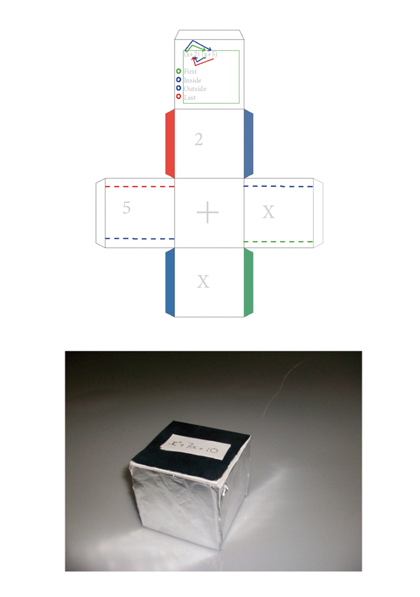
|
<< >> ANNA HUNT/CHRISTINA DAVIS/ALLEGRA GHILONI Expanding a square / You have to make (1)an object that produces something physical and that works (2) thanks to the exploitation of a human being. Tin foil also (3) has to be present. The object has to be about (5) math and (6) memory. The title has to feature (6) /.  The above are the guidelines our group were given to begin the SIBI project. From this we were led to thinking about Maths problems and the way our brainʼs are able to remember and understand them. Memory Retrieval is a function of the brain when the answer to a problem or question is found quickly and is a relatively automatic process. Strategy-Based Memory Solutions are when the brain is reliant on a strategy or system to enable it to understand and remember solutions to more complicated problems (for example quadratic equations) and it is this process that we chose to explore further. When generating our idea we found that we followed the Neo-Darwinian Strategy. Initially we broke down each area of the brief into separate categories and brainstormed ideas relating to each one of these. We then re-evaluated and analyzed these ideas to see if there were any links between the ideas in each category and worked to develop a clear path of relationship between them. We were very much struck by the relationship between maths and memory and selected the ideas based around these to develop further. We discovered that there is an ʻimportant positive relationship between the complexity of arithmetic or maths problems and the demand on the working memory for problem solvingʼ*. Reading this caused our ʻinsight momentʼ and we decided to develop an object that assists the working memory in complex problem solving. We directed our research more towards memory to see how we could link this with mathematics. We discovered that colour, sense, imagery and human exploitation are all memory triggers. They are used to help us remember information that we find difficult or otherwise dull, it dresses it up and makes it intriguing. ʻZbrodoff & Logans 2005 Reviewʼ describes that as a problem increases the more that errors occur. To calculate simple problems (for example 2 + 2) the brain uses memory retrieval and requires less time and consideration to process. As numbers increase so does the size of the problem, a sum such as 7 + 8 will take longer to produce a solution for. Therefore as problem size increases so does the possibility of error which then leads our working memory to use strategy based solutions. Further research into this allowed use to discover that FOIL in fact is not just a material, as we thought, but is a strategy used in mathematics to help memorize quadratic equations. Foil is an acronym ; First Outside Inside Last. Using this we combined both our research of memory and of mathematics to formulate a solution to the guidelines. We developed a tool to be used when solving quadratic equation. The process used make the equations simple and interactive to learn allowing the participant to absorb the information more easily and decreases room for error so information is then more likely to be stored in the participants long term memory due to the learning process involved. Furthermore once this has occurred it will mean that reactions to quadratic equations will become a faster translation to a more retrieval memory based approach. In our case we found that the relationship between constraints and creativity was a positive one. We found that being given set constraints as a starting point for this project very beneficial as it gave us a base to begin developing ideas from and meant that the ideas we did generate were focussed and linked well. It provided us with a clear route to follow when developing our idea further and we found that after the ʻinsight periodʻ our ideas flowed and linked easily. A second benefit of starting this project with set constraints and guidelines was that it reduced the time we could have initially spent trying to decide an area to begin the project from as it provided us with a clear starting point and meant inspiration and focus came much quicker and easier. We do however understand that this may not always be the case when creative problem solving as in some cases the constraints may hinder the creative process and put a limit on how far ideas are able to be developed if they are the meet the guidelines correctly. We also found our creative process was further aided by the following factors of motivation and personality. Motivation is the driving force that pushed a person into action. In our case we found we were pushed by intrinsic motivation (ʻmotivation comes from the pleasure one gets from the task itself or from the sense of satisfaction in completing or even working on a taskʼ*) rather than extrinsic motivation (motivation that comes from outside an individual. The motivating factors are external, or outside, rewards such as money or grades. These rewards provide satisfaction and pleasure that the task itself may not provideʼ*). We have found this project to be different from anything we have previously worked on. This provided us with curiosity in a new experience and meant we were interested in our involvement and outcome of the project as it provided us with a positive challenge. Personality also assisted our creative process. Creative personalities are said to possess the following traits including determination, open-mindedness, self confidence and willingness to grow and take risks. While working on the project we discovered that we all posses these traits, making working as a team much easier. We also discovered that, having all come from different social backgrounds and all having different past experiences we each interpreted guidelines differently and from this each generated different solutions. We found this to be positive because it meant our idea pool was broad and gave us many options with which to work from and develop, making the final outcome more interesting. We believe our intellectual abilities also played a large part in our group dynamic and creative process. For us to work successfully as a group we needed to be able to analysis and articulate our ideas to each other well, meaning that if one of us had an idea we needed to be able to possess a strong communicative ability to ensure other group members understood and strong analytical abilities to asses whether the said idea was a strong one and how to develop it. We found that as we all possessed these personality traits it was easy to explain our thoughts and we frequently found we all agreed on the ideas and areas that were worth developing. This resulted in ideas being developed and pushed forward quickly as we all understood clearly which direction to move towards and created a positive group dynamic, meaning there were no hindrance to the creative process. To conclude we feel our diversity in personality and independent experience's have allowed us to pitch a wider field of ideas and these, combined with following the Neo-Darwinian creative process, have allowed us to develop a concept based on in-depth research which we feel has created a product with a clear relevance to out brief and has a strong outcome. << >> |